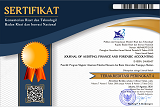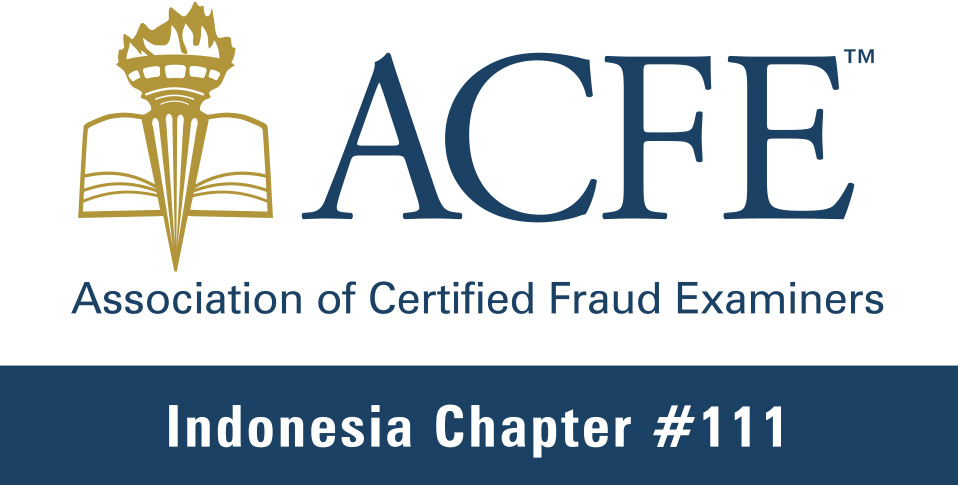JOURNAL OF AUDITING, FINANCE AND FORENSIC ACCOUNTING
WRITING GUIDELINE
FORMAT
- 1. Typing
- The article should be typed using the Microsoft Word program, in Bookman Old Style with the size of 10 pt, single spaced (before = 0 pt, after = 0 pt).
- The paper size is A4. The boundary of upper, lower, and side margins are 3 cm.
- The article’s length is around 10-15 pages (not including references and attachments).
- The article should be written in Bahasa Indonesia and English.
- 2. Writing the article
a) Title
- Title of the article is written on the first page.
- Title should contain 11 words at the most.
- The title should contain the keywords of research results and avoid the following terms: analysis, influence, relationship, study, case study, impact, role.
- The title should be written in bold capital letters, with a letter size of 12 pt, single spaced and centered.
- If there is an additional title which belongs to the main title, the additional title is written after the main title, in capital letters and separated from the main title by a colon.
b) Author’s identity
- Author’s identity is written on the first page.
- The author’s name is written without academic degree and last name must not be abbreviated, bold, 10 pt.
- The author’s identity should be accompanied with instution’s name and institution’s address (street name, city, zip code, country), and email address, not bold, 10 pt.
- If there are more than one authors, the identity of the other author(s) should be written completely.
c) Abstract
- The abstract should be written in Bahasa Indonesia and English
- The abstract should be written in one paragraph, single spaced, in Bookman Old Style with a size of 10 pt.
- The length of the abstract should not exceed 200 words and accompanied by three to five keywords.
- The keywords are written in Italics, in regular letters with a capital at the beginning of the first keyword and ended with a period.
d) Writing the Sub-title
- Sub-title (level 1) is written uprightly in bold letters, with a capital letter at the beginning of each word, and centered.
- Sub-sub-title (level 2) is written in bold italics, with a capital letter at the beginning of each word, and centered.
- Sub-sub-sub-title (level 3) is written in bold italics, with a capital letter at the beginning of each word, and left aligned.
- Sub-sub-sub-sub-title (level 4) is written in regular italics, with a capital letter at the beginning of paragraph and ended with a period.
- Conjunctive and preposition in each level is not written in capital letters.
e) Presenting Tables
- Each table is given a chronological number (Arabic numeral), title of the table, and source if the table is taken from other sources.
- Number and title of table is written above the table, in bold letters and centre aligned.
- Number of table is written above title of table, with a capital letter at the beginning of each word.
- Table title is written under table number, with a capital letter at the beginning of each word.
- Table source is written under the table, centre aligned.
- Table is written in 10 pt. letters and single spaced.
- Table design: Table title and column title, column title and table content, table content and table source, are separated by horizontal lines (vertical lines are not necessary).
- Chronological numbers are not necessary inside the table.
f) Presenting Picture/Diagram
- Each picture is given a chronological number (Arabic numeral), title of the picture, and source if the picture is taken from other sources.
- Number and title of picture is written below the picture, written in one line, in bold letters and left aligned. No. of picture is ended with a period.
- Number and title of picture is written with a capital letter at the beginning of the sentence.
- Picture source is written under the number and title of picture, centre aligned.
- The letters in the picture is written in 10 pt. letters and single spaced.
g) Presenting Indirect quotation
Indirect quotation is written inside the sentence without quotation marks and accompanied by source of the quotation which includes author’s last name and year.
h) Presenting Quotation source
- Single author
Accompanied by author’s last name followed by year of publication.
- Example of quotation source for short direct quotation:
Rakhamwati (2017) stated that “..........” (p. 100).
- Example of quotation source for indirect quotation:
A study on .......... (Rakhamwati, 2017).
- Two authors
Accompanied by last names of the two authors, followed by year of publication, for example:
- Rakhamwati and Prasetyo (2017) proved that ..........
- The formation of human resources .......... (Rakhamwati & Prasetyo, 2017).
- Three to five authors
The first mention is accompanied by all the authors’ last names, the following mentions is only accompanied by the first author’s last name followed by et al., for example:
- First mention: Alim, Tarjo and Prasetyono (2016) stated that ..........
- Following mentions: Alim et al. (2016) proposed that ..........
- Six or more authors
Accompanied by first author’s last name followed by et al. and year of publication, for example:
Musyarofah et al.(2015) suggested that ..........
- Quotation source of more than one authors uses “and”, and uses the symbol “&” when presented in brackets, table, picture, and the list of references.
i) Presenting mathematics and statistics formulas
Mathematics and statistics formulas and notations are written in italics.
j) Presenting the list of references
- Should include all the sources used in the article.
- The references should be from publications of the latest ten years and minimally 70% of them are taken from primary references (Jurnals and Patents).
- The list of references should be arranged alphabetically according to authors’ last names (without academic degrees).
- Quotation source and list of references should comply with the system of American Psychological Association (APA), as follows:
- Book with one author
Henry, A. (2011). Understanding strategic management. Oxford: Oxford University Press.
- Book with two authors
Brigham, E. F. & Ehrhardt, M.C. (2010). Financial management: Theory & Practice. Thirteen Edition. Boston: South-Western College Publishing.
- Article from a book containing a compilation of articles
Moretti, E. (2011). Local labor market. In O. Ashenfelter, & D. Card (Eds.), Handbook of labor economics volume 4B (pp. 1237–1313). North Holland: Elsevier.
- Book with no author
Merriam-Webster’s collegiate dictionary. (2013). Spring-field, MA: Merriam-Webster.
- Periodicals: jurnal and magazine
Weinberg, M.C. (2011). More evidence on the performance of merger simulations. American Economic Review, 101(3), 51–55.
- Newspaper article with author
Schwartz, J. (2012, September 30). Obesity affects economic, social status. The Washington Post, pp. Al, A4.
- Newspaper article with no author
New drug appears to sharply cut risk of death from heart failure. (2012, July 15). The Washington Post, p. A12.
- Paper from Seminar, workshop, and training
Suharyadi, A. (2011). Mix-methods approach and attributed problems in impacts evalua tion. A paper presented in the workshop: Impacts Evaluation in the Social Intervention Program, Depok, Indonesia.
- Institution official document
- Bursa Efek Indonesia. (2010). Directory of the indonesian capital market: Supporting institutions and supporting professionals. Jakarta: Bursa Efek Indonesia.
- Internet
Strauss, J. (2011). Global growth hits soft patch, expected to rebound. Retrieved November 18, 2013, from http://www.imf.org/external/pubs/ft/survey/2011/NEW06171A.
- 3. All pages of the article should be given chronological numbers which are put in the center bottom of each page.
Journal of Auditing, Finance, and Forensic Accounting
Program Magister Akuntansi
Fakultas Ekonomi dan Bisnis Universitas Trunojoyo Madura
Jl. Raya Kamal PO BOX 2 Kamal, Bangkalan, Jawa Timur- Indonesia
Telp. 031 3013483
Email: jaffa.trunojoyo@.gmail.com















